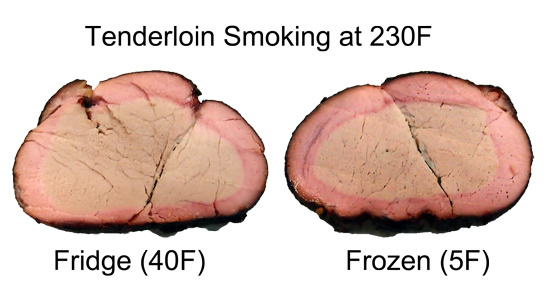| g e n u i n e i d e a s | ||||||
 |
 |
 |
 |
 |
 |
 |
| home | art and science |
writings | biography | food | inventions | search |
| a tale of two tenderloins |
|
June 2010 Despite the name, pork tenderloins are relatively lean and are easily overcooked. While many people bake their tenderloins as if they were pork shoulders (i.e. 180F to convert collagen to gelatin), I prefer to stop at 140F while the interior is still juicy and flavorful. However, this shortens the smoking time- but a few tricks will set things right. Technique I: From freezer to plate Smoke is attracted to cold wet surface by thermophoresis. By smoking a frozen tenderloin, the meat stays colder and moister longer. The smoke ring is uniform and thick, and the interior juicy. Plus, you always have a frozen tenderloin ready in the freezer if guests arrive on short notice. Here's the recipe:
Notice how the frozen tenderloin's ring is more uniform than meat smoked right from the fridge:
I also use a similar technique for brisket- salt, rub and let dry brine for 2 days in the fridge. Then freeze, and when it's time to cook dinner, smoke right out of the freezer. Depending on the smoker's temperature, whether you use the Texas Crutch, and so on this technique might add 4 hours to the cook. But wickedly convenient and the results are excellent Technique II: Brown and smoke At 225F, meat will not brown after only a few hours cooking in the smoker. Which is too bad, because significant flavor develops during high temperature searing1. Why not have the best of both worlds, by searing first and smoking second? Turns out the smoke ring's dimensions and cooking times are barely affected, but the flavor profile takes a huge step forward. Smoky, rich and dark. Here's the recipe:
You can also combine both methods- brown first (this also kills most surface bacteria), then rub, then freeze. Smoke when the urge hits. |
|
--------------------------------------------------------------------------------------------------------
1 Note the idea that searing seals in moisture is a myth. The assertion goes back at least as far as statements made by the German chemist Justus von Liebig in the 1850s, claiming that browned surface proteins chemically bond into an impermeable layer, trapping juices. Harold McGee, among others, have shown this simply isn't accurate. I've found there is a modest grain of truth in this old saw. The browned surface slows juices from oozing out, especially when you cook quickly at high temperatures. But, if you let the meat rest before slicing, almost all those juices end up on the plate before they make it into your mouth. Salting can bond juices inside the meat, and some treatments (like xanthan gum) can seal the meat into a steaming sarcophagus, but searing is ineffective. |
 Contact Greg Blonder by email here - Modified Genuine Ideas, LLC. |
